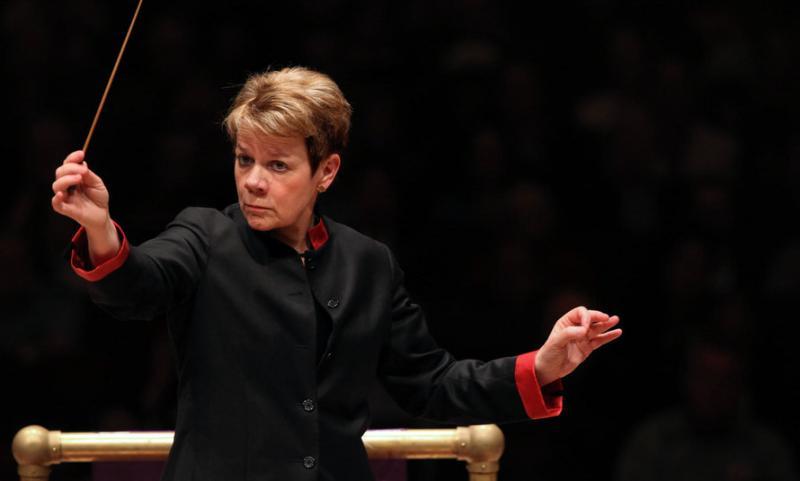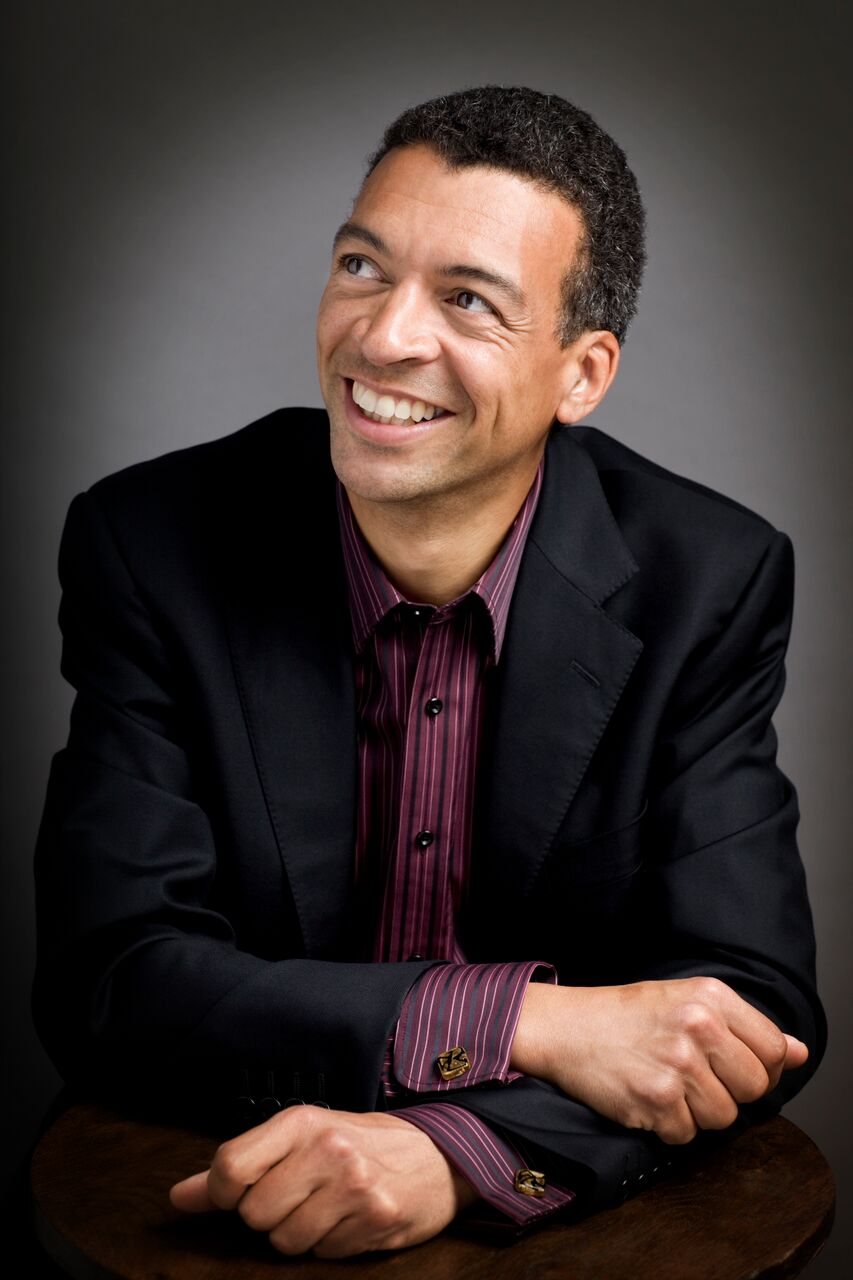Williams, LPO, Alsop, RFH review - sleek lines and pastoral tones | reviews, news & interviews
Williams, LPO, Alsop, RFH review - sleek lines and pastoral tones
Williams, LPO, Alsop, RFH review - sleek lines and pastoral tones
Power and precision in all-British programme, but the music retains its poetry

The London Philharmonic’s Isle of Noises, a year-long festival dedicated to music of the British Isles, drew towards its close with this programme of Butterworth, Elgar and Walton. Marin Alsop was a good choice to lead, especially for Walton’s Belshazzar’s Feast.
Choral skills, too, in Belshazzar’s Feast. Walton makes huge demands on the singers, and Alsop expected nothing but the best from the London Philharmonic Chorus, regularly taking the singers to dynamic extremes, especially in the many quiet, unaccompanied passages, but always maintaining that rhythmic focus. The opening chorus, lacked precision in some of the phrase endings, but the chorus soon found their feet, with particularly impressive diction and balance between the sections.
Better still was soloist Roderick Williams (pictured below by Benjamin Ealovega). As he ages, Williams’ baritone gains in richness and colour, and although his projection and vocal presence may be diminished, he still carried across the huge orchestra with ease. His experience in opera and recital was evident in his ability to convey narrative and emotion, and to bring subtly different character to each of his arias: straightforward narrative for “Babylon was a great city”, colourful and clearly conscious of the libretto’s absurdity in “Praise ye the God of Gold!”, and stentorian for the writing-on-the-wall climax.
 In the work’s climaxes, Alsop skilfully marshalled the orchestral forces, balancing the huge brass section, including two offstage bands, against the rounder weight of the orchestral strings, and underpinned by the rich organ pedal. Walton often changes gears mid-way through these tutti passages, and Alsop is able to steer the huge forces with the nimbleness of a string quartet. Incisive percussion add the final ingredient, clearly delineating the music’s shape and driving the work to a thundering – but always carefully balanced – conclusion.
In the work’s climaxes, Alsop skilfully marshalled the orchestral forces, balancing the huge brass section, including two offstage bands, against the rounder weight of the orchestral strings, and underpinned by the rich organ pedal. Walton often changes gears mid-way through these tutti passages, and Alsop is able to steer the huge forces with the nimbleness of a string quartet. Incisive percussion add the final ingredient, clearly delineating the music’s shape and driving the work to a thundering – but always carefully balanced – conclusion.
Elgar’s Enigma Variations is a gentler work, but again, Alsop ensured that the orchestra never rested on its laurels. Where other conductors might present the opening theme as a blank slate, Alsop brought intense emotion from the opening bar. And drama, too, with even the main theme given symphonic scope. The sheer precision of the LPO string sound risks making this, or any music, sound like clockwork. Alsop kept that string sound steady, but often contrasted it with more boisterous woodwind ensembles, no less precise, but emphasising colour over coordination. And when Elgar focuses his attentions on the strings, Alsop was always able to draw rich, expressive playing from them. Some excellent solos here, from principal cello Pei-Jee Ng, whose wistful, sweeping phrases beautifully set the tone for the GRS variation, and from principal viola, whose brief cantilenas were the heart of the Dorabella portrait. As in the Walton, Alsop was particularly impressive at the climax, bringing warmth and dynamism from the very start of the EDU variation, and not only maintaining the intensity, but subtly raising the temperature through carefully gauged increases in tempo and dynamic, again executed with unerring precision by the LPO players.
The concert opened with George Butterworth’s A Shropshire Lad, timely for its inevitable Remembrance Day connotations – Butterworth died at the Battle of the Somme. Not that any justification is needed to programme such elegant and heartfelt music. For the first few phrases, it seemed that Alsop’s dynamism and focus would mask the rhapsodic beauty of this miniature, but it soon became clear that her detail and colour were just what this music needed. And there was no lack of poetry, with Alsop and the orchestra soon settling into elegant and pastoral tones, all clearly defined but no less bucolic for it.
rating
Share this article
The future of Arts Journalism
You can stop theartsdesk.com closing!
We urgently need financing to survive. Our fundraising drive has thus far raised £49,000 but we need to reach £100,000 or we will be forced to close. Please contribute here: https://gofund.me/c3f6033d
And if you can forward this information to anyone who might assist, we’d be grateful.

Subscribe to theartsdesk.com
Thank you for continuing to read our work on theartsdesk.com. For unlimited access to every article in its entirety, including our archive of more than 15,000 pieces, we're asking for £5 per month or £40 per year. We feel it's a very good deal, and hope you do too.
To take a subscription now simply click here.
And if you're looking for that extra gift for a friend or family member, why not treat them to a theartsdesk.com gift subscription?
more Classical music
 Anja Mittermüller, Richard Fu, Wigmore Hall review - a glorious hall debut
The Austrian mezzo shines - at the age of 22
Anja Mittermüller, Richard Fu, Wigmore Hall review - a glorious hall debut
The Austrian mezzo shines - at the age of 22
 First Person: clarinettist Oliver Pashley on the new horizons of The Hermes Experiment's latest album
Compositions by members of this unusual quartet feature for the first time
First Person: clarinettist Oliver Pashley on the new horizons of The Hermes Experiment's latest album
Compositions by members of this unusual quartet feature for the first time
 Gesualdo Passione, Les Arts Florissants, Amala Dior Company, Barbican review - inspired collaboration excavates the music's humanity
At times it was like watching an anarchic religious procession
Gesualdo Passione, Les Arts Florissants, Amala Dior Company, Barbican review - inspired collaboration excavates the music's humanity
At times it was like watching an anarchic religious procession
 Classical CDs: Camels, concrete and cabaret
An influential American composer's 90th birthday box, plus British piano concertos and a father-and-son duo
Classical CDs: Camels, concrete and cabaret
An influential American composer's 90th birthday box, plus British piano concertos and a father-and-son duo
 Cockerham, Manchester Camerata, Sheen, Martin Harris Centre, Manchester review - re-enacting the dawn of modernism
Two UK premieres added to three miniatures from a seminal event of January 1914
Cockerham, Manchester Camerata, Sheen, Martin Harris Centre, Manchester review - re-enacting the dawn of modernism
Two UK premieres added to three miniatures from a seminal event of January 1914
 Kempf, Brno Philharmonic, Davies, Bridgewater Hall, Manchester review - European tradition meets American jazz
Bouncing Czechs enjoy their Gershwin and Brubeck alongside Janáček and Dvořák
Kempf, Brno Philharmonic, Davies, Bridgewater Hall, Manchester review - European tradition meets American jazz
Bouncing Czechs enjoy their Gershwin and Brubeck alongside Janáček and Dvořák
 Solomon, OAE, Butt, QEH review - daft Biblical whitewashing with great choruses
Even a top soprano and mezzo can’t make this Handel paean wholly convincing
Solomon, OAE, Butt, QEH review - daft Biblical whitewashing with great choruses
Even a top soprano and mezzo can’t make this Handel paean wholly convincing
 Two-Piano Gala, Kings Place review - shining constellations
London Piano Festival curators and illustrious friends entertain and enlighten
Two-Piano Gala, Kings Place review - shining constellations
London Piano Festival curators and illustrious friends entertain and enlighten
 Echo Vocal Ensemble, Latto, Union Chapel review - eclectic choral programme garlanded with dance
Beautiful singing at the heart of an imaginative and stylistically varied concert
Echo Vocal Ensemble, Latto, Union Chapel review - eclectic choral programme garlanded with dance
Beautiful singing at the heart of an imaginative and stylistically varied concert
 Scott, Irish Baroque Orchestra, Whelan, RIAM, Dublin review - towards a Mozart masterpiece
Characteristic joy and enlightenment from this team, but a valveless horn brings problems
Scott, Irish Baroque Orchestra, Whelan, RIAM, Dublin review - towards a Mozart masterpiece
Characteristic joy and enlightenment from this team, but a valveless horn brings problems
 Classical CDs: Voice flutes, flugelhorns and froth
Baroque sonatas, English orchestral music and an emotionally-charged vocal recital
Classical CDs: Voice flutes, flugelhorns and froth
Baroque sonatas, English orchestral music and an emotionally-charged vocal recital

Add comment